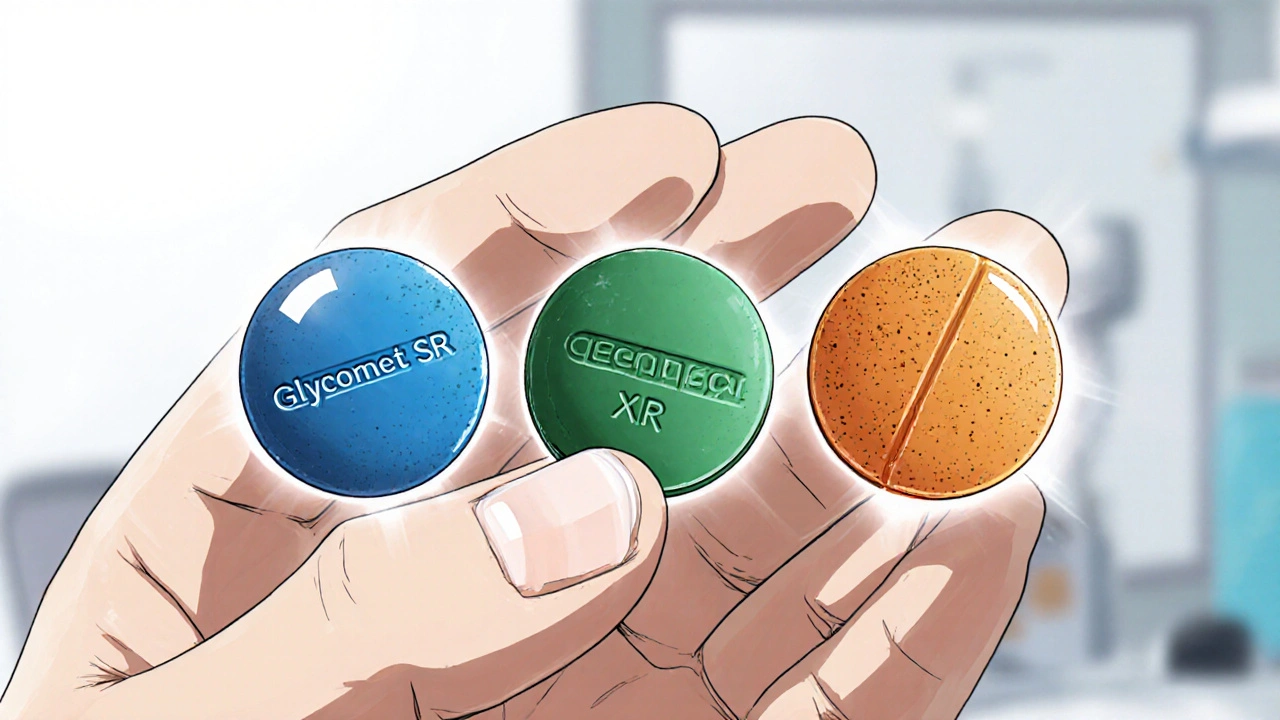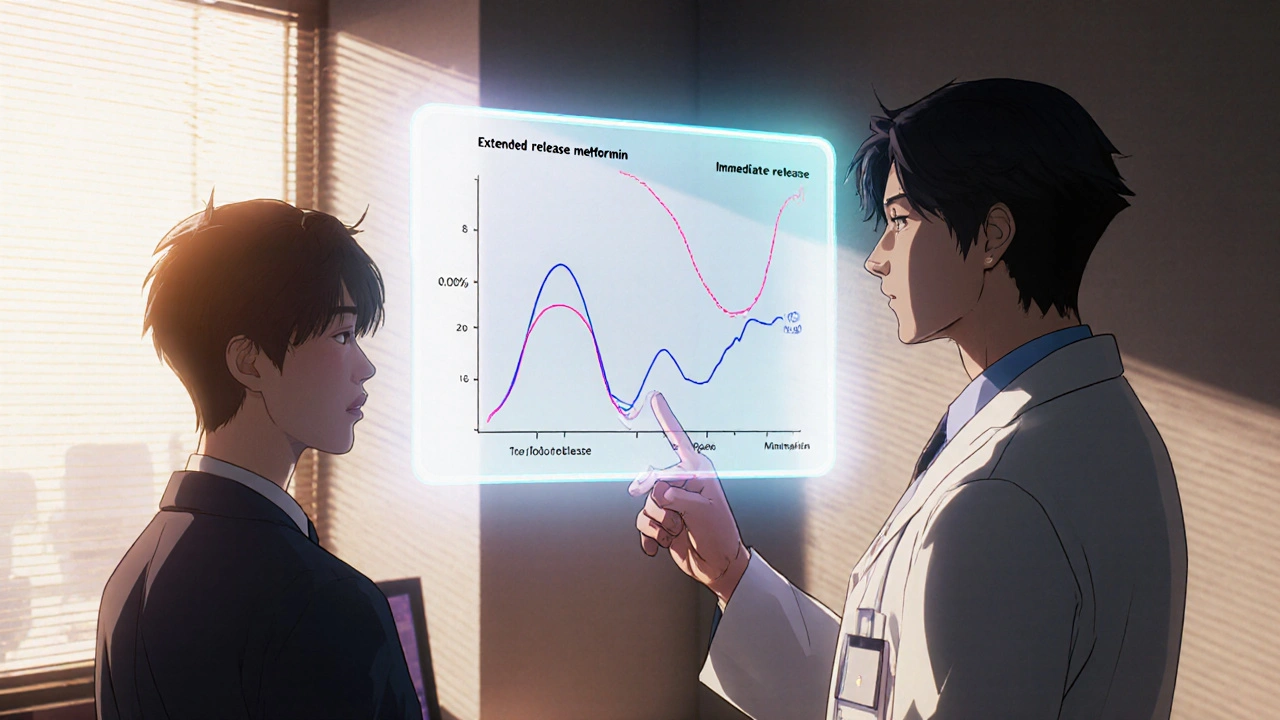Diabetes Medication Selector
Question 1: GI Tolerance
Do you struggle with gastrointestinal (GI) side effects like nausea or diarrhea on metformin?
Question 2: Cost Priority
Is cost the most important factor for your medication choice?
Question 3: Renal Health
What's your estimated eGFR (ml/min/1.73 m²)?
Question 4: Weight Considerations
Are you concerned about weight gain or loss with your medication?
Question 5: Dosing Convenience
How important is once-daily dosing for you?
Trying to figure out whether Glycomet SR is the right fit for your type‑2 diabetes can feel like a maze. You want steady blood‑sugar control, minimal side‑effects, and a price that won’t break the bank. This guide breaks down Glycomet SR, its extended‑release magic, and the most common alternatives, so you can decide with confidence.
What is Glycomet SR?
Glycomet SR is a branded extended‑release formulation of metformin, a first‑line oral therapy for type‑2 diabetes. The “SR” stands for “slow‑release,” meaning the tablet releases metformin gradually over 12‑14hours, allowing once‑daily dosing for many patients.
How Does Extended‑Release Metformin Work?
Metformin lowers glucose production in the liver and improves insulin sensitivity. In the SR version, the drug is coated with a polymer that dissolves slowly, flattening the peak‑and‑trough pattern seen with immediate‑release tablets. The result is smoother blood‑sugar curves, fewer gastrointestinal (GI) complaints, and better adherence.
Key Factors to Compare When Choosing a Diabetes Medication
- Efficacy: How much does the drug lower HbA1c?
- Side‑effect profile: GI upset, weight change, risk of hypoglycaemia.
- Dosage convenience: Once‑daily vs multiple doses.
- Renal safety: Metformin requires adequate kidney function; other drugs have different thresholds.
- Cost & insurance coverage: Branded vs generic, and any co‑pay differences.

Side‑by‑Side Comparison Table
| Medication | Formulation | Typical Dose | HbA1c Reduction | Key Side‑effects | Renal Cut‑off | Cost (AUD per month*) |
|---|---|---|---|---|---|---|
| Glycomet SR | Extended‑release metformin | 500‑2000mg once daily | -0.7% to -1.0% | Less nausea, mild diarrhea | eGFR≥45ml/min/1.73m² | ≈$25‑$35 |
| Metformin Immediate‑Release | Immediate‑release | 500‑1000mg twice daily | -0.6% to -0.9% | Higher GI upset, must take with meals | eGFR≥30ml/min/1.73m² (with dose‑adjustment) | ≈$15‑$25 |
| Glucophage XR | Extended‑release generic metformin | 500‑2000mg once daily | -0.7% to -1.0% | Similar to Glycomet SR, slightly more GI reports | eGFR≥45ml/min/1.73m² | ≈$18‑$28 |
| Pioglitazone | Thiazolidinedione | 15‑45mg once daily | -0.5% to -0.8% | Weight gain, edema, rare heart‑failure risk | eGFR≥30ml/min/1.73m² | ≈$30‑$40 |
| Empagliflozin | SGLT2 inhibitor | 10‑25mg once daily | -0.5% to -0.7% | UTIs, genital infections, mild dehydration | eGFR≥30ml/min/1.73m² (lower efficacy <45) | ≈$70‑$90 |
| Sitagliptin | DPP‑4 inhibitor | 100mg once daily | -0.4% to -0.6% | Rare pancreatitis, mild headache | No renal dose‑adjustment needed >15ml/min/1.73m² | ≈$50‑$65 |
Deep Dive into the Alternatives
Metformin Immediate‑Release
For decades, the immediate‑release (IR) version has been the workhorse of diabetes therapy. It’s cheap and effective, but the need for twice‑daily dosing and the higher chance of nausea can be a turn‑off. If you’re already on Glycomet SR and tolerate it well, moving to IR usually offers no extra benefit.
Glucophage XR
Glucophage XR is the generic counterpart to Glycomet SR. Bio‑equivalence studies show similar plasma‑level curves, so the clinical outcomes mirror each other. The price gap is modest; some Australian pharmacies list Glucophage XR a few dollars less per month. If insurance prefers generics, this is the go‑to switch.
Pioglitazone
Pioglitazone hits a different pathway - it activates PPAR‑γ receptors to boost insulin sensitivity. It’s useful when metformin alone doesn’t hit target HbA1c, especially in patients with fatty liver disease. However, the weight‑gain and fluid‑retention side‑effects make it less attractive for those already overweight or with heart‑failure risk.
Empagliflozin (SGLT2 Inhibitor)
Empagliflozin works by prompting kidneys to dump excess glucose in the urine. Besides modest HbA1c drops, it reduces cardiovascular events and slows kidney disease progression. The downside is cost and a higher infection risk. It’s a solid add‑on if you need extra glucose‑lowering power and have a decent eGFR.
Sitagliptin (DPP‑4 Inhibitor)
Sitagliptin preserves the body’s own incretin hormones, increasing insulin release after meals. It’s weight‑neutral and has a very low hypoglycaemia risk when used alone. The HbA1c impact is modest, so it’s typically paired with metformin rather than used as a stand‑alone alternative.
Decision Guide: Which Option Fits Your Life?
Answer these quick questions to narrow the field:
- Do you struggle with GI upset on metformin? - Try the ER version (Glycomet SR or Glucophage XR) or switch to a non‑metformin class.
- Is cost the biggest barrier? - Immediate‑release metformin or generic Glucophage XR are cheapest.
- Do you have heart or kidney disease? - Empagliflozin offers cardio‑renal protection, but watch renal cut‑off.
- Are you gaining weight on your current meds? - Avoid pioglitazone; consider DPP‑4 inhibitors or SGLT2 inhibitors.
- Do you need once‑daily dosing for convenience? - Choose any extended‑release metformin or SGLT2/DPP‑4 inhibitors.
Combine the answers with your doctor’s advice, and you’ll land on the medication that balances efficacy, safety, and lifestyle.

Practical Tips for Switching or Staying on Glycomet SR
- Gradual transition: If moving from IR to SR, start with half the total daily dose for a week, then increase to full dose.
- Monitor renal function: Get an eGFR test before any change; repeat every 6‑12months.
- Watch for VitaminB12: Long‑term metformin can lower B12; annual labs help catch deficiency early.
- Side‑effect mitigation: Take the tablet with dinner, avoid alcohol spikes, and consider a short course of an anti‑nausea med if needed.
- Insurance check: Some PBS listings favor generic Glucophage XR; verify your copay before refilling.
Frequently Asked Questions
Frequently Asked Questions
Can I take Glycomet SR and a SGLT2 inhibitor together?
Yes, combining metformin (SR or IR) with an SGLT2 inhibitor like empagliflozin is a common strategy. Metformin handles hepatic glucose production while the SGLT2 drug increases urinary glucose excretion, giving a complementary drop in HbA1c. Always check renal function first because both drugs need adequate kidneys.
Why does Glycomet SR cause less nausea than regular metformin?
The extended‑release coating spreads the drug’s absorption over many hours, avoiding a high peak concentration in the gut that triggers nausea. This smoother release also reduces the chance of diarrhea.
Is Glycomet SR safe during pregnancy?
Metformin, including the SR form, is classified as FDA pregnancy category B and is widely used for gestational diabetes when benefits outweigh risks. Discuss with your obstetrician; many clinicians continue metformin throughout pregnancy.
What should I do if I miss a Glycomet SR dose?
Take the missed tablet as soon as you remember, unless it’s close to the next scheduled dose. In that case, skip the missed one and resume the regular schedule-don’t double up.
How often should I have my HbA1c checked while on Glycomet SR?
Standard practice is every 3months after a medication change, then every 6months once the target is stable. Your doctor may adjust timing based on overall control.


Richard O'Callaghan
October 17 2025I was on Glycomet SR while juggling night shifts, and defnitely felt less nausea than the IR version, but I also noticed a weird metallic taste sometimes that kinda freaked me out, especially when I was low on sleep. The once‑daily dosing was a lifesaver for my crazy schedule, and I could finally take my med with dinner without remembering to split doses. If you have a sensitive stomach, the SR coating really does spread the drug out, which helped me avoid the typical bloating. Just make sure your kidneys are still happy, because the eGFR cutoff is real – I got a quick blood test before switching and felt better after. Also, I’d suggest checking B12 once a year; I caught a deficiency early thanks to a routine checkup. Overall, it felt like a smoother ride, even if the price tag was a tad higher than the generic.